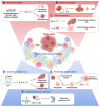Interleukin-8 in Colorectal Cancer: A Systematic Review and Meta-Analysis of Its Potential Role as a Prognostic Biomarker
- PMID: 36289899
- PMCID: PMC9599846
- DOI: 10.3390/biomedicines10102631
Interleukin-8 in Colorectal Cancer: A Systematic Review and Meta-Analysis of Its Potential Role as a Prognostic Biomarker
Abstract
Among soluble actors that have emerged as druggable factors, the chemokine interleukin-8 (IL-8) has emerged as a possible determinant of response to immunotherapy and targeted treatment in several cancer types; however, its prognostic/predictive role in colorectal cancer (CRC) remains to be established. We: (i) conducted a systematic review of published literature on IL-8 expression in CRC; (ii) searched public transcriptomics databases; (iii) investigated IL-8 expression, by tumor and infiltrating cells, in a series of CRC samples; and (iv) carried out a meta-analysis of published literature correlating IL-8 expression and CRC prognosis. IL-8 possesses an important role as a mediator of the bidirectional crosstalk between tumor/stromal cells. Transcriptomic analysis indicated that specific IL-8 transcripts were significantly overexpressed in CRC compared to normal colon mucosa. Moreover, in our series we observed a statistically significant correlation between PTEN-loss and IL-8 expression by infiltrating mononuclear and tumor cells. In total, 12 papers met our meta-analysis inclusion criteria, demonstrating that high IL-8 levels significantly correlated with shorter overall survival and progression-free survival. Sensitivity analysis demonstrated a highly significant correlation with outcome for circulating, but not for tissue-detected, IL-8. IL-8 is overexpressed in CRC tissues and differentially produced by tumor or stromal components depending on CRC genetic background. Moreover, circulating IL-8 represents a strong prognostic factor in CRC, suggesting its use in the refining of prognostic CRC assessment and potentially the tailoring of therapeutic strategies in individual CRC patients.
Keywords: IL-8; advanced CRC; anti-angiogenic drugs; chemotherapy; prognosis; tumor–stroma interactions.
Conflict of interest statement
The authors declare no conflict of interest. Figure 1 of this manuscript was created with BioRender.com.
Figures







References
Grants and funding
LinkOut - more resources
Full Text Sources
Other Literature Sources
Medical
Research Materials
Miscellaneous

